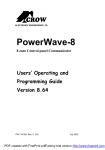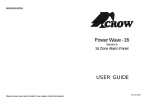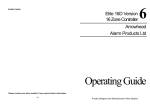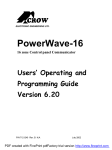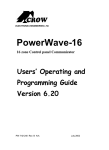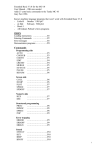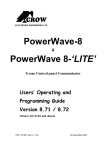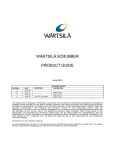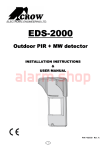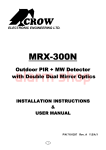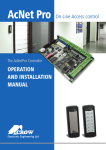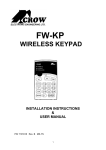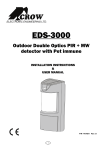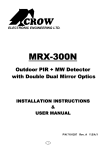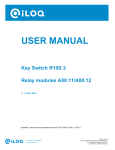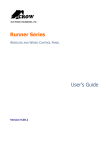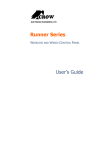Download Powerwave 64 User Manual
Transcript
ELECTRONIC ENGINEERING LTD. POWERWAVE- 64 64 zone Wireless Control panel Users’ Operating and Programming Guide P/N 7121 Rev. B N.A Version 1.0X NOV. 2002 Corporate Head Office: 429 Nepean Hwy, Brighton East, Vic., 3187 Australia FAX: E-MAIL: WEB: (61)-0(3)-9596-0888 [email protected] www.crowaust.com.au 2 Contents Introduction .......................................................................................................... 5 Meet the Crow Alarm Control System .................................................. Typical Alarm System Configuration.................................................... Keypad Description ............................................................................................... 6 Buttons................................................................................................. Audible Signals .................................................................................... Indicators ............................................................................................. KEYPAD TAMPER (wrong code alarm).............................................. Display................................................................................................. Summary of Functions.......................................................................... Operation ........................................................................................................... 11 How to Arm the System before Exit ................................................... 11 How to Arm the System when Staying Home ..................................... 12 How to Arm Partitions........................................................................ 13 How to Bypass Zones......................................................................... 14 How to use Chime (If enable by Installer).......................................... 14 Emergency Alerts ............................................................................... 15 Generate Threat or Duress .................................................................. 15 How to Read System Messages .......................................................... 15 How to Read Trouble Messages.......................................................... 16 How to Display Events from Memory................................................. 17 How to Control Outputs and Devices.................................................. 17 How to Get into to User Program/Client Mode ................................... 17 How to Change or Add Codes ............................................................ 18 How to Change Master Code.............................................................. 18 3 How to Add or Change User Code...................................................... 19 How to Add or Change Telephone Numbers....................................... 19 How to set Time and Date .................................................................. 20 How to start Walk test Mode .............................................................. 20 Customizing your Keypad .................................................................. 21 How to Adjust Keypad Backlight Level.............................................. 22 How to Adjust Buzzer Tone................................................................ 23 Warranty ............................................................................................ 25 4 Introduction Meet the Crow Alarm Control System Thank you for choosing to protect your premises with a PreeWave-64 (FW64) of Crow Electronic Engineering Ltd. Power Wave of Crow Electronic Engineering Ltd. is a highly advanced, multifunction Wireless alarm control system, designed to flawlessly manage your security system at home or at business, protects you against burglary and supports the operation of electronic devices. The FW64 has many incredible program options that can enhance the standard features of the panel from simple “Home Automation” to “Radio control” and Voice Prompted Command control”. Please ask your installer to find out more about these powerful features. You can phone your home to check or change the status of any output using the keys on your phone. Arm or disarm the whole house or just one area, all with voice confirming your selections. Imagine turning on the spa before leaving work so it is hot when you get in the door. The under-floor heating has just automatically switched on using the on board timer and you have just opened the rollerdoor and disarmed the garage from your cell phone so the white ware repairman can work on your washer. It also has a comprehensive alarm event memory that stores all of the controller activity with the time and date. Typical Alarm System Configuration The protected premises can be divided up to 64 zones, as defined by the installation scheme. The protected area can be grouped into 4 separate partitions (A,B,C,D). The system can be grouped for User ‘s convenience to separate, in a business environment, the offices from the warehouse area, or in a private residence, the different rooms of the home, e.g., living room, bedroom, etc. Each zone can react differently to various events, to generate an alarm or activate a device. The system can be armed in two different modes: 1) Arm –the protected areas are entirely vacated 2) Stay –people and pets populate the protected areas. The User who has access to the keypad's control features, can change the settings. The system can be accessed via multiple keypads (each located at a different site). Up to 8 keypads can be integrated into the system. Access levels and Users’ access codes are detailed below. 5 Keypad Description The LCD Keypad shows all the information required to operate the system. The User communicates with the alarm system via the keypad. The Keypad displays continuous information about the status of the alarm system, and enables the User to operate the system in different modes, change settings and program Users' access codes. The keypad also collects and records events to be displayed afterward on request, to overview system activities, and to analyze system performance for diagnostics. Buttons The 21 silicone rubber buttons are used for the following functions Numeric Keys - In Operating mode the numeric keys are used for entering Access codes. In Program mode the numeric keys are used for entering program addresses and new values. Text buttons - are used as function buttons and select the options indicated by the text and normally precede other button presses. PROG Key is used to prefix option selections in the program modes and also used prior to a Master or Installer Code to enter one of the program modes from normal operating mode. ENTER Key is used after entry of a sequence of numbers (e.g. entry of a User code to Arm or Disarm the system). As a User code can be 1-6 digits in length, the panel will not accept a code entry until the Enter key is pressed. 6 Audible Signals The keypad emits signals (beeps) in response to User activities. These signals are listed in Table. Table: List of Audible Signals Sound Sequence Description Short beep Once only A key in the keypad has been pressed 3 short beeps Once only Operation carried out successfully Long beep Once only Illegal operation, or wrong key pressed Slow beeping Through the Exit or Entry delay time Exit or entry delay warning when arming the system indicates that you must exit the protected area, also Entry delay warning when entering via the entry zone, to disarm the system. Indicators The indicators show the status of the system. The LED indicators are listed in Table 2. Table: List of LED Indicators Design. Function Bypass Indicates that there are bypassed zones Stay Indicates that the system is armed in STAY mode Armed Indicates that the system is fully armed, or a partition is armed Ready Indicates that the system is ready to be armed Trouble Indicates system failure, or problem. Make note of system message and call service KEYPAD TAMPER (wrong code alarm) A wrong code or Keypad Tamper alarm is generated by the FW64 after 4 consecutive invalid code entries. The controller will not “Lock-Out” the keypad at this point but simply create an alarm condition that may be reported to a monitoring company via the dialler. Entry of a valid user code will reset the Keypad Tamper alarm, however, the alarm event will be written into memory and the keypad will display “New Event” indicating the presence of a new memory entry. 7 Display The LCD window holds 2 rows of 16 characters each. The display shows: • System Messages • Open Zones • System Status • Trouble Messages • Memory Events • Description of zones • Zone numbers during programming • Device numbers during control Summary of Functions Function Keys Full or Partition Arm C CODE C Full Arm C ARM Disarm during exit C ARM Disarm C CODE C C Arm Partition Arm Stay Description Initiates full arm ENTER ENTER A or C C C CODE C ENTER Arm Stay C Initiates full arm Only if enabled by installer Disarms the system during exit delay Only when slow beeping is emitted Disarms the system Stopping Alarms Arms partition A or B Press A or B for 2 seconds to arm relevant partition Only if enabled by installer Initiates partial alarm when the user is home Only if enabled by installer B STAY Notes Initiates partial alarm when the user is home STAY 8 Function Keys Disarm Stay C CODE C Disarm Stay C STAY Bypass C BYPASS Description Notes Disarms the system ENTER Disarms the system C C Bypasses a zone(s) Repeats the procedure to unbypass zones CONTROL Activates emergency alert Press simultaneously for 2 seconds Zone # ENTER Initiate Panic C CHIME Initiate Medical Alarm C CHIME + B Activates emergency alert Press simultaneously for 2 seconds Initiate Fire Alarm C A + B Activates emergency alert Press simultaneously for 2 seconds Memory C Initiates display of events from memory. Displays events, and automatically scrolls to the next event every 2.5 sec. (Use arrow key to scroll up manually) + MEM <ENTER> cancels memory readout Chime Enable/dis able C Control C CHIME CONTROL C Device# C ENTER Change or Add Users' code C Customize keypad C Function PROG C M CODE C ENTER CONTROL + ARM Keys Enable or disable chime function Holds the key for 2 sec to alternate. Only if enabled by installer Activates or deactivates outputs and devices Press <Control> for 2 seconds Activates program mode to add or change Users' codes For details see page 17 Enters Local Edit Program Mode Press Control and then Arm, and hold both simultaneously for 2 sec For details see page 19 Description 9 Notes Increase LCD backlight level C CONTROL + STAY Decrease LCD backlight level C CONTROL + BYPASS Increase LED backlight level C CONTROL + Decrease LED backlight level C CONTROL + Increase Speaker volume C CONTROL + 6 Decrease Speaker volume C CONTROL + 9 User Message Recorder C CONTROL + 5 User Message Player C CONTROL + 8 Note: Hold <CONTROL> and press <STAY> repeatedly to increase light Hold <CONTROL> and press <BYPASSS > repeatedly to decrease light Hold <CONTROL> and press <MEM> repeatedly to increase light MEM Hold <CONTROL> and press < > repeatedly to decrease light Hold <CONTROL> and press <6> repeatedly to Increase volume Hold <CONTROL> and press <9> repeatedly to decrease volume Hold <CONTROL> and press <5> to Record the message Hold <CONTROL> and press <8> to Play the message If you started an operation incorrectly, press <ENTER> to exit and return to the previous mode. 10 Operation How to Arm the System before Exit Preparing the System for Arming Verify that the green <Ready> indicator is lit. This indicator is lit only when all zones are closed (all doors, exits and windows are closed and motion in the protected area is restricted or bypassed). If the green <Ready> indicator is not illuminated, the LCD displays the open zones and descriptions. Close open zones, or bypass them. Bypass any zone you cannot close. For details see page 12. Note: Bypassed zones are not protected. Arming the System PowerWave 64 DATE TIME When the system is ready, the LCD display shows the system type, date and time, and the green <Ready> indicator is lit. Before leaving premises the system has to be armed. Arming the alarm system will turn on all detectors in the partition /s being armed. When the system is Ready, enter user code and then <ENTER> to arm the system. Enter Code **** The system prompts you to exit the protected area. Areas Exiting A--There is a exit delay prior to the system being armed. During this delay time you can leave the premises. At the end of the procedure, the ARMED indicator lights up to indicate that the system is armed, and the system message is displayed. (The indicators may go out after a few seconds, depending on the installer's setting). Areas Armed A--Quick Arm When enabled by the installer, press <ARM> to arm the system. 11 During this delay time, a slow beeping is heard to indicate that the system is not armed yet and reminds you to leave the protected area. If you must disarm the system during the exit delay, press <ARM>. Disarming the System Enter User’s code and press <ENTER>. The following system message is displayed: Areas Disarmed A--Stopping Resetting Alarms In case of an alarm condition Enter User’s code and press <ENTER> to stop alarm any time, and turn off any audible sirens. How to Arm the System when Staying Home This type of arming is used when people are present within the protected area. At nighttime, when the family is about to retire, perimeter zones are protected, but not the interior zones. Consequently, interior movements will be ignored by the system. When the system is Ready, press <STAY> and the system prompts you to enter user code, and then <ENTER>. Enter Code **** Quick Stay When enabled by the installer, press <STAY> to arm the system. During exit delay you can leave the premises. If you wish to stay or that no one will enter the protected premises, you may cancel the Entry/exit delay by pressing the <ENTER> key. The slow beeping stops and the system is immediately armed. At the end of the procedure, the Stay indicator lights up to indicate that the system is armed and the system message is displayed. (The indicators may go out after a few seconds, depending on the installer's setting). Areas In Stay A--Disarming the System Enter user’s code and press <ENTER>, or press <STAY> if enabled by installer. The following system message is displayed. 12 Areas Disarmed A--- How to Arm Partitions The protected area can be grouped into 4 separate partitions (A, B, C, D). The system can be grouped for User ‘s convenience to separate, in a business environment, the offices from the warehouse area, or in a private residence, the different rooms of the home, e.g., living room, bedroom, etc. To arm partition A enter user code for partition A To arm partition B enter user code for partition B To arm partition C enter user code for partition C To arm partition D enter user code for partition D Note: to arming partition with code see page 9 “How to arm the system before exit” During exit delay you can leave premises. At the end of the procedure, the ARMED indicator lights up to indicate that the system is armed, and the system message is displayed Areas Armed A--(The indicators may go out after a few seconds, depending on the installer's setting). To disarm partition, see "Disarming the System". If enabled by the installer, to arm the partition A, press <A> for 2 seconds. To arm partition B, press <B > for 2 seconds The same procedure is also applicable to partition B. Areas Exiting -B During exit delay you can leave premises. At the end of the procedure the ARMED indicator lights up to indicate that the system is armed and system message is displayed. (The indicators may go out after a few seconds, depending on the installer's setting). Areas Armed -B 13 To disarm partition, see "Disarming the System". Note: to arming partition with code see page 9 “How to arm the system before exit” How to Bypass Zones Bypass any zone that cannot be closed. You can bypass selected zones prior to arming. It is also used to temporarily exclude a faulty zone from service, which requires repair. To bypass a selected zone, press <BYPASS>, Bypass indicator lights up to indicate that the system is in bypass mode. Enter the zone number (e.g. 01, 05, 12, 47) one or more zones. Bypass Zones 01 05 12 Following press <ENTER>, the system displays the bypassed zones. Zone 1 Bypass Zone 1 While in the Bypass mode it is possible to bypass more than one zone, press <BYPASS>, Bypass indicator lights up to indicate that the system is in bypass mode, Add the zone number (e.g. 03) one or more zones, following press <ENTER>, the Bypass indicator lights up to indicate zone(s) bypassed. To un-bypass zones, press <BYPASS>, enter zone number (e.g.05,12) and press <ENTER>. Note: Disarming automatically un-bypasses all zones. How to use Chime (If enable by Installer) A Chime (Day zone) is a detector that can be part armed while you are at home but working in another part of the building. It can be programmed to operate a buzzer or light to let you know you have a visitor. To disable this function, press <CHIME> for 2 seconds, as shown below. Chime OFF To enable this function, press <CHIME> for 2 seconds, as shown below. Chime ON 14 Emergency Alerts This three special key’s function is best programmed by your installer to suit your individual situation. Most commonly it is used in a panic situation. These are a “PANIC”, “FIRE”, and “MEDICAL” alarm. Pressing two buttons simultaneously generates the Fire and Medical alarms How to initiate Panic Press the <PANIC> or Press simultaneously <1>and <3>. How to initiate Medical Alarm Press simultaneously <7> and <9>. How to initiate Fire Alarm Press simultaneously<4> and <6>. Generate Threat or Duress If you are compelled to disarm the system under threat, you must enter the duress digit before the user’s code to activate the automatic dialer. The duress digit shifts up your usual code by one digit. If your code is 345 and 8 is your duress digit, than entering 8345 will modify your code. The modified duress code will disarm the system in a normal way, but at the same time will activate the dialer silently to report a “duress event” without arousing suspicion. (For details ask installer.) How to Read System Messages When viewing the memory events at the keypad by pressing the <MEMORY>, the first thing that will always be displayed is the system messages. Following the display of current system alarms the panel will then sequence through the 255 historical memory events starting at the most recent event. Any system failure that may that may occur, is indicated by system messages. System messages are automatically displayed and are listed in Table 4. Read messages and call for service. 15 Table 4: System Messages Message Description/Action Battery Low The backup battery is low (charger or battery failure) Main Failure The main power is disconnected, or caused by power outage. Telephone Line Failure The line is disconnected Radio Device Battery Low Replace battery of the particular device Supervise Detector Failure Radio detector failed to communicate Zone Inactivity Time-out No movement detected during expected time in this zone Dialer Kiss-off Failure Communication fail How to Read Trouble Messages Any failure or abnormal events that may occur are indicated by trouble messages, and the Trouble indicator is lit. Press <MEMORY> to read out messages and other events stored in memory. Any failure or -abnormal events that may occur are indicated by trouble messages, and the Trouble indicator is lit. Press <MEM> to read out messages and other events stored in memory. Trouble messages are listed in Table 5. Table 5: Trouble Messages Message Description/Action Zone Tamper The tamper of a particular zone System Tamper Main cabinet open Pendant Panic Panic alarm initiated via radio pendant Panic Panic alarm initiated via keyboard Fire Fire alarm initiated via keyboard Medical Medical alarm initiated via keyboard Duress code used Duress digit pressed by one of the users, under threat 16 How to Display Events from Memory The system memory stores the last events. Press <MEMORY> to display list of events. Following the display of current system alarms the panel will then sequence through the 255 historical memory events starting at the most recent event. The system will display the last event and automatically scroll to the next one every 2.5 seconds, and a beep is emitted. Use the arrow keys to scroll up manually. Wait until all messages are displayed, or press <ENTER> to cancel memory readout. How to Control Outputs and Devices The keypad enables control of external devices, such as an air-conditioner or heater. To activate or halt a device, press <CONTROL> for 2 seconds and the number of the device. Up to 8 different devices can be controlled via the keypad. Control Mode ---4---When you enter control mode the system prompts you to enter device # and then <ENTER> to activate or deactivate the selected device. How Local command control works If a command control code for outputs is programmed and the output/s are allowed to be locally controlled from the keypad, then entering the 4 digit code at a keypad will now indicate the output status e.g. if output 1 is on And the number of the device. Up to 8 different devices can be controlled via the keypad. Control Mode 1------When you enter control mode the system prompts you to enter device # and then <ENTER> to activate or deactivate the selected device. How to Get into to User Program/Client Mode There are 2 levels of program mode, CLIENT mode and INSTALLER mode. Normally the installer will give you access to the CLIENT mode so you can add, delete, or change the user codes. If you request it your installer can provide you with access to the INSTALLER mode as well. To get into CLIENT mode provided the system is NOT armed 17 Press <PROGRAM> enter Master code and <ENTER>. The Program indicator lights up to indicate that the system is in User programming mode. If you get a single long beep at this point and the Program LED doesn’t turn on, it means your code cannot access Program mode. How to exit program mode To exit out of program mode press <PROGRAM> and <ENTER>. The LCD display shows the system type, date and time. PowerWave 64 DATE TIME How to Change or Add Codes About Master code and User code The factory default master code (123) is intended as a preliminary control of the alarm system. After FreeWave is installed and put into service, the code can be changed to any code known to the Master user. The Master user can define up to 99 user codes. To limit access rights, the holder of the Master code can ask the installer to define several User profiles. Access rights are listed below: - User code has Area A and/or B or C or D permission - User code can arm and/or disarm arm an area - User code can arm and/or disarm arm an area in Stay mode - User code can change their code - User code can change user’s code - User code can change dialer telephone numbers - User code can alter the real time clock - User can answer an incoming call and start up/down load - User can allow access to installer program mode from client mode. - Initiate Walk-test mode. How to Change Master Code While in CLIENT mode, Press <PROGRAM> and 1 to change Master code press <ENTER>, the code digit will be flashed back to you. Use the numeric keyboard to enter your new Master code. The code can hold any combination of 1 to 6 digits. It is recommended using a multi-digit code. . Press <ENTER> to save your new code, the 18 new code will be flashed to you and 3 short beeps to indicate correct entry or 1 long beep if not accepted. Press <PROG> and <ENTER> exit user Code Program mode. Press <PROG> enter Master code and <ENTER>. The display will show “Client Mode”. Client Mode How to Add or Change User Code While in CLIENT mode, press <PROG> and the User number (2 to 99) to add or change the code. Use the numeric keyboard to enter the new code. The code can hold any combination of 1 to 6 digits. Press <ENTER> to save your new code. User 3 Code 56789 Repeat the procedure for all users or use arrow (MEM) key to advance to next user. Press <PROG> and <ENTER> to exit Local Program mode. How to Delete User Code While in CLIENT mode, press <PROG> and the User number (2 to 99) you intend to delete. The display shows the code. User 8 Code 8765 Press <CONTROL> and<0> simultaneously to delete User code. Press <ENTER> to save the change. Press <PROG> and <ENTER> exit Client Program mode. How to Add or Change Telephone Numbers Your panel will accept up to 6 phone numbers with a total of 16 digits. Your panel can be can be programmed to dial all or any of these depending on the event which has occurred.(The six phone numbers are at program address 691 through to 696). While in CLIENT mode, key in the following sequence <PROGRAM> <691> <ENTER> (The address for telephone number 1), The existing number will be flashed out at the Keypad then enter <NEW TELEPHONE #> <ENTER> The new numbers will be flashed back to confirm acceptance. 19 At any time you can enter in the address for the telephone number just to view the currently programmed value then press the <PROGRAM> button to move on to another address. Note: Address 6911 = PH # 1, 692 = PH# 2 to 696 = PH# 6. (Note: on the LED keypad “0” is indicated by LED “A” and “9” by LED “B”) How to set Time and Date The alarm system has an internal clock that may be used to automatically Arm or Disarm the alarm or turn Outputs On or off. It is also used to identify when events occurred in memory via the LCD keypad. Should you need to change the Time & Date it must be done from CLIENT mode. To change the Time & Date press Press <PROGRAM> <678> <ENTER> <1-7> <ENTER> Where 1-7 = the current day (1=Sun, 2 = Mon to 7 = Sat) Press <PROGRAM> <679> <ENTER> <HHMM> <ENTER> Where HH = Hour in 24 Hour Format and MM = Minutes Press <PROGRAM> <680> <ENTER> <1-31> <ENTER> Where 1-31 = the current date Press <PROGRAM> <681> <ENTER> <1-12> <ENTER> Where 1-12 = the current month Press <PROGRAM> <682> <ENTER> <YY> <ENTER> Where YY = current year, e.g. 02=2002 How to start Walk test Mode While in CLIENT mode a User with the proper authority can start walk-test mode. This special mode latches the alarm signals from detectors at the keypad initiating the test so that one person can trigger every detector connected to the alarm then return to the keypad to verify operation. On terminating Walk-test mode the test results are put into the memory buffer so they can be viewed at a later time. To start Walk-test mode while in CLIENT mode press <PROGRAM> <956> <ENTER> The keypad buzzer will beep at 1-second intervals Next trigger every detector connected to the panel then return to the keypad and all of the zones that were triggered will be displayed at the keypad. To terminate Walk-test mode press <ENTER> The keypad will stop beeping and automatically exit CLIENT mode. 20 How to Answer an in-coming call From time to time your installer may need to access the alarm from a remote PC to make changes to your programming and for security reasons they may have configured the alarm so that an authorized person on-site is required to make the alarm system answer the in-coming call. This option is only available in CLIENT mode. To answer an In-coming Call press <PROGRAM> <955> <ENTER> Provided the line connected to the alarm was ringing at the time the panel will now answer the call and allow a remote PC connection. Customizing your Keypad Local Edit Program mode assists the user to customize descriptions, adjust keypad light and buzzer tone. How to Enter Local Edit Program Mode to Describe Zones To enter this mode, press simultaneously <CONTROL> and <ARM> for 2 seconds. The display will show “Local Mode kb #”. From hereon, you can change the numeric description of a zone to a textual description. Press <PROG> <1> to change the description of Zone 1. For example, Use the arrow keys to move the cursor forward or backward on the display. Press the corresponding key to replace the current digit. Each key represents 3 different characters. The first character will be shown at the first press, etc. Press <MEM> to change from uppercase to lowercase and visa-a-versa. Zone 1 Bedroom <A..Z> During the programming of text for all of the addresses 1-8,998,999 you can also use the <A> button to return back to last saved text and you can use <B> button to return back to the default text. Press <ENTER> to save textual description. For more zones, press <PROG>, followed by Zone # to continue textual description. The functions of the alphanumeric keys are listed in Table 6. 21 Table 6: Summery of Alphanumeric Keys st Button # 1 Press 2nd Press 3rd Press 4th Press 1 2 3 4 5 6 7 8 9 0 * (‘) A (a) D (d) G (g) J (j) M (m) P (p) S (s) V (v) space # (<) B (b) E (E) H (h) K (k) N (n) Q (q) T (t) W (w) Y (y) = (>) C (c) F (F) I (i) L (l) O (o) R (r) U (u) X (x) Z (z) 1 2 3 4 5 6 7 8 9 0 How to Program System Description In client mode, Press <PROG> <999> and then <ENTER>. You may enter any name for your system (up to 16 characters). Name <A..Z> Johnson Family To save changes, press <ENTER>. How to Program Area Description In client mode, Press <PROG> <998>, and then <ENTER>. character, one per each area. You may edit any To save changes press <ENTER>. To update and transfer programmed textual information from one LDC keypad to another, press <CHIME> for 2 seconds. To exit Local Edit Program Mode and return to Idle Mode, press <PROG> and then <ENTER>. How to Adjust Keypad Backlight Level The User can adjust the backlight of the keys and LCD display in 16 steps, from Fully illuminated to Off. To increase LCD backlight, hold <CONTROL> and press <STAY> repeatedly until the light is increased to its maximum. 22 To decrease LCD backlight, hold <CONTROL> and press <BYPASS> repeatedly until the light goes off. To increase keyboard backlight, hold <CONTROL> and press <MEM> repeatedly until the light is increased to its maximum. To decrease keyboard backlight, hold <CONTROL> and press < > repeatedly until the light goes off. How to Adjust Buzzer Tone The User can adjust the volume of the buzzer tone can be adjusted, in 16 steps, from fully On to Off. To increase the volume, hold <CONTROL> and press <A> repeatedly until it is increased to its maximum. To decrease the volume, hold <CONTROL> and press <B> repeatedly until it is decreased to off. How Remote command control works Another powerful feature available from your alarm is Command Control. This feature is a remote control facility which allows valid users to access the panel via a standard touch tone telephone and check or change the Arm/Disarm status of each of the areas, operate each of the eight outputs or turn on an optional Microphone. To perform any of the Command Control features you must first ring the phone number, which the panel is connected to. The panel may be set up to answer after a specific number of rings of it may be set-up to use a fax defeat option. Either way, when you ring the phone number and the panel answers the call, the first thing you will hear over the phone is a burst of modem tone for two seconds. After this tone has stopped you must enter the access code, which is associated with the Command menu option you wish to access. Remember, the code you enter will determine which menu option you access. If you miss the pause, the panel will repeat the modem tone and then again pause for 5 seconds looking for your access code. This process will be repeated 4 times before hanging up if no valid code is received. When entering codes or other information in Command Control the "#" key acts as a "Clear" button. When you have entered the required 4-digit access code the panel will reply with the status message associated with the Command Control function you have accessed. For example, lets say we have a code of “2045” to allow Arming & Disarming of Area A. Once the code “2045” has been received the panel checks the current status of Area A and replies with the pre-programmed voice message relating to that status e.g. if Area A is Armed then the Armed message will be sent, if Disarmed then the Disarmed message will be sent. If only the DTMF board is fitted, the voice message is substituted with a long beep if Area A is Armed, and three short beeps if it is disarmed. Once the status message has informed you of the actual state, you can use the "*" key to toggle the option on & off or Arm and Disarm, e.g. in our example above, code “2045” accesses Area "A" arming or disarming. 23 Assuming the status message we received was "Area A alarm is Armed" If we press the "*" key, Area "A" will be Disarmed and we would receive a status message "Area A alarm is Disarmed" (or whatever message is programmed by the installer) While you are on-line with the panel you can move between menu options by entering the code of the option you want to control. Assuming there was a code of “4321” programmed to control outputs. After having used code “2045” to control the Arm/Disarm status of Area A, we first press the “#” button to reset all previous entries. Then we can enter the digits “43215” (that is “4321” as the code to control outputs and “5” to select output #5). The current status of output #5 will be given either by the voice message or the appropriate tone and then the status can be changed with the “*” button on the remote telephone (Note; For output control you must enter in the 4 digit code e.g. 4321 followed by the output number you wish to control, in this case 5). At any stage, if you enter in an incorrec t code you can press the “#” button on the remote telephone to clear all code entries and then start again. To turn on the optional Microphone (only available if the Voice Board is fitted) you must enter in the appropriate code followed by the “*” button. To turn the Microphone off you simply press the “*” button again. To end a Command Control session simply hangs up the phone. The panel is monitoring the line at all times and 15 seconds after the last key press it will automatically hang up the line. This 15-second timer is active during the whole command control process so a period of 15 seconds without a key press will cause the panel to hang-up. 24 Warranty CROW LIMITED WARRANTY (Crow) warrants this product to be free from defects in materials and workmanship under normal use and service for a period of one year from the last day of the week and year whose numbers are printed on the printed circuit board inside his product. Crow’s obligation is limited to repairing or replacing this product, at its option, free of charge for materials or labor, if it is proved to be defective in materials or workmanship under normal use and service. Crow shall have no obligation under this Limited Warranty or otherwise if the product is altered or improperly repaired or serviced by anyone other then Crow. There are no warranties, expressed or implied, of merchantability or fitness for a particular purpose or otherwise, which extend beyond the description on the face hereof. In no case shall Crow be liable to anyone for any consequential or incidental damages for breach of this or any other warranty, expressed or implied, or upon any other basis of liability whatsoever, even if the loss or damage is caused by Crow’s own negligence or fault. Crow does not represent that this product can not be compromised or circumvented; that this product will prevent any person injury or property loss or damage by burglary, robbery, fire or otherwise; or that this product will in all cases provide adequate warning or protection. Purchaser understands that a properly installed and maintained product can only reduce the risk of burglary, robbery or other events occurring without providing an alarm, but it is not insurance or a guarantee that such will not occur or that there will be no personal injury or property loss or damage as a result. Consequently, Crow shall have no liability for any personal injury, property damage or any other loss based on claim that this product failed to give any warning. However, if Crow is held liable, whether directly or indirectly, for any loss or damage arising under this limited warranty or otherwise, regardless of cause or origin, Crow’s maximum liability shall not in any case exceed the purchase price of this product, which shall be the complete and exclusive remedy against Crow. 25 Use the following form to record your changes and customizations. User 1 2 3 4 5 6 7 8 9 10 11 12 13 14 15 16 17 18 19 20 21 22 23 24 25 26 27 28 29 30 31 32 33 34 35 36 37 38 39 Name Out Device Designation 1 2 3 4 5 6 7 8 Zone 1 2 3 4 5 6 7 8 9 10 11 12 13 14 15 16 26 Zone Name Notes: 27



























